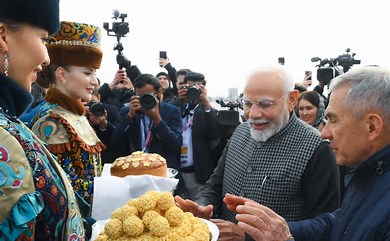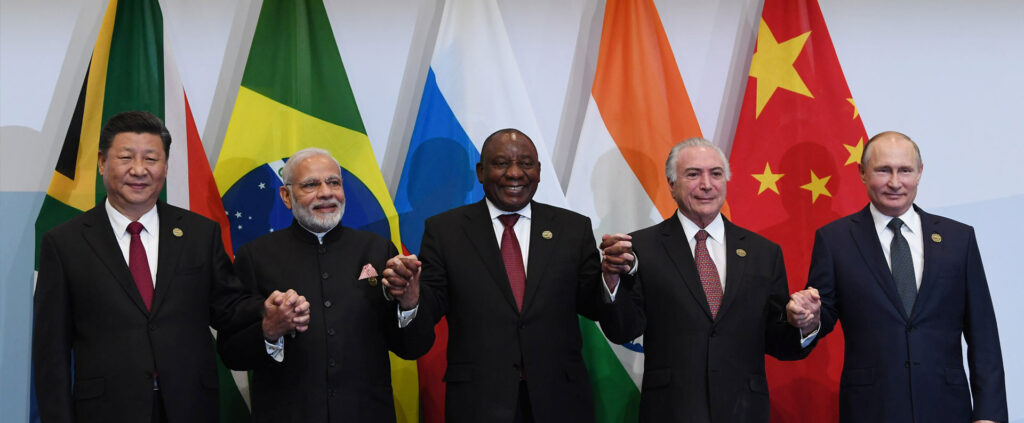BRICS is a coalition of five major emerging economies: Brazil, Russia, India, China, and South Africa. Since its inception, the BRICS group has been a platform for these countries to cooperate on issues related to economic growth, trade, and political influence on the global stage. This group represents about 42% of the world’s population and contributes significantly to global economic output.

History of BRICS
The term BRIC was initially coined in 2001 by Jim O’Neill, an economist at Goldman Sachs, to describe the growing influence of Brazil, Russia, India, and China in global affairs. These countries were identified as potential leaders in global economic growth due to their large populations and rapidly expanding economies. However, it was only in 2006 that the group began formal meetings.
In 2010, South Africa joined the group, expanding the acronym to BRICS. This inclusion gave the group a more diversified global representation, spanning across multiple continents—South America, Asia, and Africa.

Objectives of BRICS
The BRICS countries have several key objectives:
- Economic Growth and Cooperation: BRICS focuses on promoting economic cooperation between its member states by facilitating trade and investment. These countries aim to reduce their reliance on developed economies and create their economic growth engines.
- Reforming Global Financial Institutions: BRICS countries seek to reform global financial institutions like the International Monetary Fund (IMF) and the World Bank to better reflect the changing global economic landscape. The group has been critical of the dominance of Western countries in these organizations and advocates for a more balanced representation.
- Social Development: Along with economic goals, BRICS also aims to improve social and developmental outcomes in member countries. They work together on initiatives related to education, healthcare, and infrastructure development.
- Multilateral Diplomacy: The BRICS nations also focus on creating a multipolar world where emerging economies have a significant role in global governance. This is particularly important given the geopolitical tensions in today’s world, where BRICS serves as a counterbalance to Western-dominated institutions like NATO and the G7.
Member Countries of BRICS
1. Brazil
- Population: 216 million
- Economy: Brazil is one of the largest economies in Latin America, known for its agricultural exports, natural resources, and industrial base. The country is a significant player in global trade, especially in commodities like coffee, soybeans, and iron ore.
2. Russia
- Population: 146 million
- Economy: Russia is rich in natural resources, particularly energy sources like oil and natural gas. It has a significant military and political presence in the global arena and is a key player in energy exports to Europe and Asia.
3. India
- Population: 1.4 billion
- Economy: India is one of the world’s fastest-growing economies, driven by its IT industry, manufacturing, and service sectors. India is also becoming a global hub for startups and innovation.
4. China
- Population: 1.41 billion
- Economy: China is the second-largest economy in the world, heavily focused on manufacturing, exports, and technology. China’s Belt and Road Initiative (BRI) has made it a key player in global infrastructure development.
5. South Africa
- Population: 60 million
- Economy: South Africa is the most industrialized country in Africa, with strong mining, manufacturing, and financial services sectors. It is considered the gateway to the African market and plays a crucial role in the continent’s economic development.
Achievements of BRICS
Over the years, BRICS has made notable achievements:
1. New Development Bank (NDB)
In 2014, BRICS established the New Development Bank (NDB) as an alternative to the World Bank and the IMF. The NDB focuses on funding infrastructure and sustainable development projects in BRICS and other emerging economies. The bank’s capital is shared equally among its five members, with each country contributing $10 billion initially.
2. Contingent Reserve Arrangement (CRA)
The CRA is a framework aimed at providing financial support to BRICS countries in case of balance of payments issues or currency crises. It complements the NDB and is seen as a mechanism to reduce reliance on Western financial institutions.
3. BRICS Summits
The BRICS countries meet annually at the BRICS Summit to discuss global economic, political, and social issues. These summits have helped build strong diplomatic relations among member nations and have also led to collaborative efforts on issues like climate change and counterterrorism.
Challenges Facing BRICS
Despite its achievements, BRICS faces several challenges:
1. Economic Disparities
The economies of BRICS countries are vastly different in terms of size and structure. China’s economy is far larger than that of the other members, which can sometimes create tensions. Smaller economies like South Africa face difficulties in keeping pace with larger nations.
2. Geopolitical Tensions
Geopolitical conflicts, particularly involving Russia and China, have complicated the group’s dynamics. For example, Russia’s conflict with Ukraine has put it at odds with Western nations, making BRICS a potential platform for global power shifts.
3. Internal Political Issues
Each BRICS country faces internal political challenges, from Brazil’s corruption scandals to India’s internal economic reforms. These domestic issues sometimes divert attention away from BRICS’s broader objectives.
Future of BRICS
As global economic and political dynamics continue to evolve, BRICS is expected to play an increasingly prominent role in world affairs. The group’s ability to reform global financial institutions, reduce the dominance of Western economies, and collaborate on pressing global issues will determine its long-term success. Additionally, the expansion of BRICS, with countries like Argentina, Saudi Arabia, and others showing interest in joining, could reshape the global economic order.
Necessary FAQs
FAQs about BRICS
1. What is the purpose of BRICS?
BRICS aims to promote economic growth, cooperation, and social development among its member countries, as well as reform global financial institutions to give emerging economies a greater voice.
2. Which countries are part of BRICS?
BRICS consists of five countries: Brazil, Russia, India, China, and South Africa.
3. When was BRICS founded?
BRICS was officially formed in 2006 when Brazil, Russia, India, and China began formal meetings. South Africa joined the group in 2010.
4. What is the New Development Bank?
The New Development Bank (NDB) is a financial institution established by BRICS to fund infrastructure and sustainable development projects in emerging economies.
5. What are the challenges facing BRICS?
BRICS faces challenges such as economic disparities between member countries, geopolitical tensions, and internal political issues.